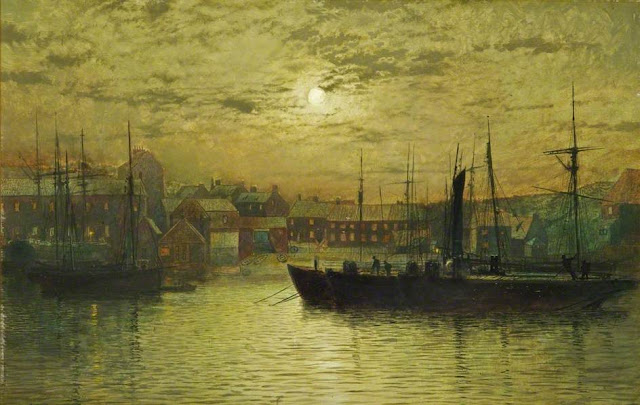In an exchange on Twitter the other day with the marvellous actor James A. Fleet (Four Weddings and a Funeral, Vicar of Dibley, and I believe made for the role of Frederick Dorrit in BBC’s ‘Little Dorrit’) about the marvellous painter John Atkinson Grimshaw I have been prompted to take another look at Grimshaw’s beautifully atmospheric works.
John Atkinson Grimshaw (1836 – 1893) was a Victorian painter known for his city scenes and landscapes. He was influenced by the Pre-Raphaelite movement initially but soon found his own ‘voice’, painting mainly urban scenes at twilight, dawn, and at night. He also indulged in some fashionable fairy paintings but personally I don’t think they’re among his best works.
He was born 6 September 1836 in Leeds. In 1856 he married his cousin Frances Hubbard (1835-1917). In 1861, at the age of 24, to the dismay of his parents, he departed from his first job as a clerk for the Great Northern Railway to pursue a career in art.
Grimshaw's paintings were sold in two art galleries, smaller picture dealers and a couple of bookshops in Leeds. One of his main customers was Thomas Fenteman, who owned an antiquarian booksellers. Fenteman was a deeply religious man and would only buy the pictures after Grimshaw had confirmed that they had not been painted on a Sunday.
He began exhibiting in 1862, under the patronage of the Leeds Philosophical and Literary Society, with paintings mainly of birds, fruit, and blossoms. Grimshaw became a popular artist in Leeds and in 1865 he was able to move with his wife to a more expensive part of the city. William Agnew, a London art dealer, began purchasing his work. Further success came when a picture by Grimshaw was accepted by the Royal Academy. By 1870 Grimshaw was in a position to buy Knostrop Old Hall, a large seventeenth-century manor house, two miles from Leeds. Fanny Grimshaw gave birth to fifteen children but only six reached adulthood.
Several of his children, Arthur Grimshaw (1864-1913), Louis H Grimshaw (1870-1944), Wilfred Grimshaw (1871-1937) and Elaine Grimshaw (1877-1970), also became painters.
I do love the textile designs of Lucienne Day. She and her husband Robin Day were a mid-century design power duo, often referred to as the British Eameses. Her designs were so groundbreaking and enduring that people still refer to them by name.
Désirée Lucienne Day was born in 1917 and died this year aged 93. Inspired by abstract art, she pioneered the use of bright, optimistic, abstract patterns in post-war England, and eventually grew celebrated worldwide.
Born in Coulsdon, Surrey, England, Day was daughter of an English mother and a Belgian father who worked as an insurance broker. She attended convent school in Worthing, and at 17 enrolled in the Croydon School of Art, where she discovered a love of printed textiles. Later she attended the Royal College of Art, where she was a top student.
Through her career, Lucienne Day won many awards, including the International Design Award of the American Institute of Decorators in 1952, and the Gran Premio prize at the Milan Triennale in 1954. In 1962, she was made a Royal Designer for Industry (RDI), an award which honours designers who have achieved "sustained excellence in aesthetic and efficient design for industry." She was the fifth woman to be made an RDI.

Her work combined organic shapes with bright patterns inspired by contemporary abstract painters such as Wassily Kandinsky and Joan Miró. She believed that good design should be affordable, and in 2003 told the Scotsman newspaper that she had been "very interested in modern painting although I didn’t want to be a painter. I put my inspiration from painting into my textiles, partly, because I suppose I was very practical. I still am. I wanted the work I was doing to be seen by people and be used by people. They had been starved of interesting things for their homes in the war years, either textiles or furniture."
Her breakthrough print was “Calyx” (see below), a brightly-coloured textile that she created for the Festival of Britain in 1951. She went on to produce hundreds of colourful abstract prints for industry clients such as Heal's.
In the 1970s, Day stopped designing mass production fabrics, turning instead to creating what she called “mosaics”: large tapestries made of thousands of pieces of Thai and Indian silk. They currently hang in the Victoria and Albert Museum, the Queen Elizabeth II Conference Centre, and the coffee shop of a John Lewis store in Kingston upon Thames.
Through a career spanning more than five decades, she stood out not just because she was a highly successful working woman during a time in which many women didn't work, but also due to her creative partnership with her husband, furniture designer Robin Day. For 50 years they worked, together but independently, in a shared studio, and their house grew to be considered the epitome of 1950s sophistication.
The development of their styles can be traced in Lesley Jackson's book Robin and Lucienne Day: Pioneers in Modern Design, published in 2001. An exhibition of Lucienne Day's textiles and Robin Day's furniture, "Robin and Lucienne Day: Design and the Modern Interior", will be held in Spring 2011 at Pallant House Gallery in Chichester — the city where the Days retired in 2000, in order to be closer to their Sussex cottage, where Lucienne spent much of her time in the garden.






















































